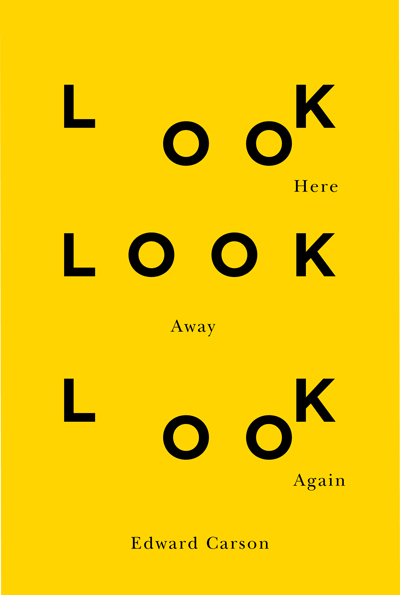
Look Here Look Away Look Again
Edward Carson
McGill-Queen’s University Press, 2019
Review by David Swartz
Edward Carson´s Look Here Look Away Look Again (McGill-Queen’s University Press 2019) is a book of poems about poetic vision. I’m struck by the beautiful impulse it encapsulates: its attention to thought in action, to what we see and think and think we see, to how time changes what we see, to how thoughts and impressions and ideas are formed in and out of time. Above all else, Carson draws attention to the search for unity in dispersion and the search for chaos within order as the heartbeat of art itself.
In the first section of his book, entitled “Pattern recognition”, Carson opens with a meditation on thought and language. He writes:
It is in thinking how
a thought begins
and what it might turn into
over time
that what soon comes
to mind is a bird.
Here the image of a bird (which will soon become the moving image of a bird flying through the sky) is not invoked as some kind of abstract poetic symbol, but as the very trajectory of the poet’s imagination and voice. For Carson, the birds song (the poets song), is something we hear with our eyes. From place to place, never the same look, never the same curve or straight line, never the same shape or size for a single period of time, but always in motion, always in flight:
Time is light unravelling,
Solving itself
Everywhere we gaze is a new plane of reality, and everything that is real in time but imaginary lines: the traces that remain of the bird’s pathway through the sky. Carson´s vision is about the simultaneous unfolding of thought through language and language through thought, the unleashing of time through its capture. In the freezing of each word and line is the bird’s freedom and slavery to both form and formlessness.
To look here is to embrace what´s going on right here in front of us, to look away is the inevitable release of concentration from what we are looking at or thinking about, but to look again means to recognize the reality of these imaginary lines of thought “for the first time / every time”, teaching us that:
nothing is more important than the truth of
what goes into what is behind what you see…
…thinking of something…
can alter it merely by thinking again much
as memory continuously revises reorganizes
reshapes what it recalls in response to new
experiences…
Carson quotes well known authors at the entrance to each of the four sections of his book. At the outset he quotes Albert Einstein on thought and language: “I rarely think in words at all. A thought comes, and I try to express it in words.” Carson juxtaposes this pithy statement with a seemingly contradictory one by Kay Ryan: “Thinking takes place in language, and its hard to say whether the language is creating the thinking or the thinking is creating the language.” Where does this leave us? Thoughts before words or words before thoughts? One way or another,Carson relentlessly explores the genesis of thinking through language. There is a turning and returning going on. As the gaze settles in and out, is cast and recast, follows this line of thought or the other, so does the subject under view change its direction.
nothing is more important than the truth of
what goes into what is behind what you see
There is nothing outside of our vision of the world. Perception, imagination and truth are one.
Carson’s book is not about life or death or the emotional charge of love or despair: rather, it is a prolonged meditation on poetic processes and how our perceptions of the world create meaning. In the end, whether or not our perceptions of things can be said to be more or less true of false according to their delusionary content, remains to be seen.
David Swartz was born in Toronto, Canada. He has been living in Lisbon, Portugal since 2013, where he teaches English at the New University of Lisbon. David´s reviews, translations, essays, poetry and artworks have appeared in international literary magazines and journals including Malahat, Smokelong, Vallum, Pinyon, Arc, and Absinthe.